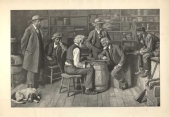The Checker Maven
The World's Most Widely Read Checkers and Draughts Publication
Bob Newell, Editor-in-Chief
Published every Saturday morning in Honolulu, Hawai`i
Noticing missing images? An explanation is here.
Happy Holidays 2018

The story of the Three Kings is a central part of Christian celebration of the holiday of Christmas. Also known as the Three Magi or the Three Wise Men, and sometimes identified as Balthasar of Arabia, Melchior of Persia, and Gaspar of India, they traveled to Bethlehem with their gifts of gold, frankincense, and myrrh, each of which is said to have a symbolic meaning. And whether you celebrate Christmas or some other holiday, the Three Kings make for a fascinating and meaningful story.
We hope you'll have a little time for checkers during the busy holiday season, and in our archives we found a "Three Kings" checker problem. We lost track of the author's name, but nevertheless the problem is very fitting--- and a bit on the difficult side.
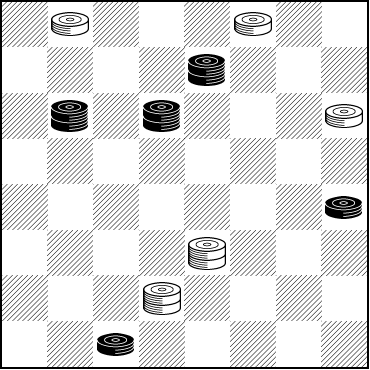
BLACK
Black to Play and Win
B:W32,30,21,K10,K7:BK26,K24,K23,13,3.
Were you able to solve it? The first move, as is often the case, is the key. We hope you gave it a good try; whenever you wish, you can click on Read More to see the solution.![]()
The American Checkerist
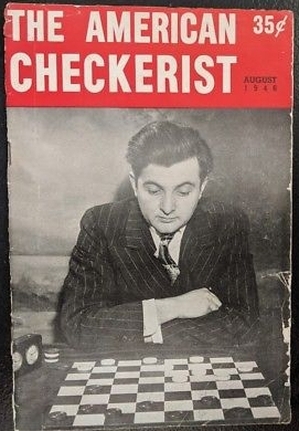
The American Checkerist was a print publication edited for many years by the prolific and talented William Ryan, who stands with Ben Boland and others among the famed golden age authors of books about checkers. Willie had a great command of the English language and wrote with a style and flair all his own.
In today's Checker School column, we have another "gem" problem, this one by William V. Scott and originally published in The American Checkerist.
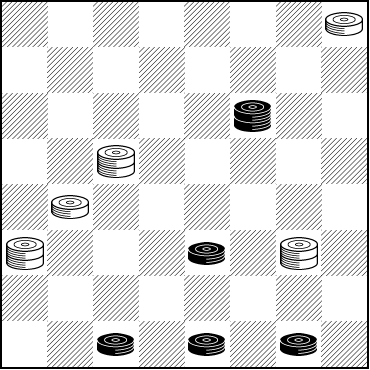
BLACK
Black to Play and Win
B:WK9,K12,16,K19,29:B1,2,3,10,K22.
Wow, what's this? Five pieces per side but White has three kings to Black's one, Black is underdeveloped, and yet Black is supposed to win it? We'd almost call this a "Coffee and Cake" problem, but a closer look shows that Black has some definite positional advantages, and the problem is actually "medium" in difficulty.
Can you make this into a Black win? You don't have to be an "American Checkerist" to solve it. Find the winning line of play and then click on Read More to see the solution. Then, see if you can answer this: the 35 cent magazine in the photo above--- what would that amount to in today's money?![]()
14th Anniversary Special Announcement

This weekend The Checker Maven completes an unbelievable 14 years of continuous publication with never a missed deadline. Week after week we've brought you something about checkers, and from what you've told us, you've seemed to enjoy it.
Originally we were going to publish for 10 years. We upped that to 15 and called that a "hard" limit. That leaves us one year to go. But we turned to Mr. Bill Salot for inspiration; he's in his eighties, going strong in every possible way, and makes no excuses about age or health as he continues to support our game of checkers.
So we're going to continue publication. There's no saying how long that will be--- your editor has serious eyesight issues, for one thing--- but we won't quit as long as we can physically continue.
It seems only fitting to celebrate this anniversary and this announcement by going back to our origins, with a "Coffee and Cake" problem from Brian Hinkle. Recall that a "Coffee and Cake" problem is one that you show to your checker friends and bet them coffee and cake that they can't solve it. Brian calls this one "Trumped" (no political reference intended).

WHITE
White to Play, What Result?
W:W10,12,24,K27:B3,7,26,K30.
Stay the course. Don't make excuses. Carry on. We wouldn't call this an easy problem, but--- like publishing The Checker Maven every week--- your efforts will be well rewarded. When you've found the right moves, click on Read More to check your solution.![]()
Thanksgiving Weekend 2018

It's another year with five Thursdays in November, so Thanksgiving in the United States comes well before the end of the month, on November 22. This column will first appear during Thanksgiving weekend.
We've always said how much we love Thanksgiving; its appeal to everyone of every faith and background makes it truly American in spirit. We hope you are enjoying the weekend in whatever way pleases you most, whether it's a large family gathering, a small intimate group, or just some days off to relax. But do remember to be thankful for what you have. While we may not have everything we want, we always have a lot more than we think.
Make checkers part of your weekend with a Tom Wiswell problem, one that he calls "The Follow Through." In his description Mr. Wiswell notes that sometimes a player will give up on a problem just a move or two short of finding the key move. In today's study, staying the course will get you there.

WHITE
White to Play and Win
W:WK4,9,K13,27,32:B3,5,K10,28.
White is a man up but is about to lose it back. How can he win?
Take a break from turkey sandwiches and pumpkin pie, and follow through to the solution. Then let your mouse follow a path to Read More to see how it's done.![]()
The Last Song

"The Last Song" can mean a lot of things; the end of a concert, maybe even the end of a career; or more metaphorically, the end of a relationship, an era ... the list goes on, and it's a bit too melancholy for our tastes. But in the world of checkers, we're looking at a much better interpretation for today's column.
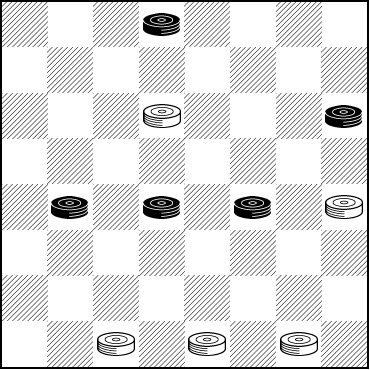
WHITE
White to Play and Win
W:W10,20,30,31,32:B2,12,17,18,19.
We're going to hear, or at least see, the last song from Mr. G. M. Gibson, the author of our recent few Checker School "snappy" problems propounded by our friend Skittle to the aspiring neophyte Nemo. We'd rate this one as a little above average in difficulty; the theme is one we've seen a few times before.
Don't let this be your last song; whether you solve it or not we hope you'll keep coming back to visit with us and that you'll keep on playing checkers. When you've sung the last verse (i.e., come up with a solution), let your mouse sing out on Read More to see how it's done.![]()
The Speed of Winter

Perhaps we say this every year --- but winter is speeding in North America, and by the time this column appears it may already be here. At our offices in Hawai`i, we'll soon have those nights when the temperature dips down below 70F, and we understand that in places such as Michigan it gets even colder than that.
And with winter speeding in, it's time for a nice little speed problem sent by regular contributors Lloyd and Josh Gordon.
We've more or less dispensed with our Javascript clock in the interests of keeping our site accessible even on the most basic browsers, or for folks who turn Javascript off as a security measure. So time yourself, if you wish. How speedy can you be in finding the solution to the problem below? It certainly falls in the "easy" category.
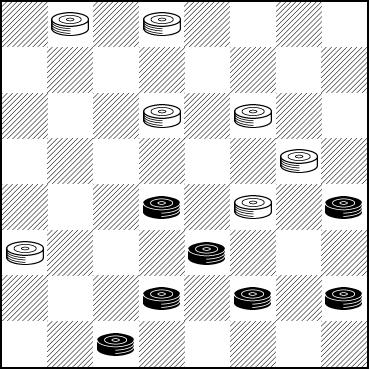
BLACK
Black to Play and Win
B:W12,14,17,22,23,31,32:B3,5,6,7,10,13,15.
Got it? We thought so, but you should still click on Read More just to be sure.![]()
The Long Crooked Trail

We've published a number of fine compositions by master problem composer Ed Atkinson, and today we have one that Mr. Atkinson calls The Long Crooked Trail.
Ed tells us, "The first part is original then it runs into old published play as credited in the notes. This ending is a study in the opposition and its changes."
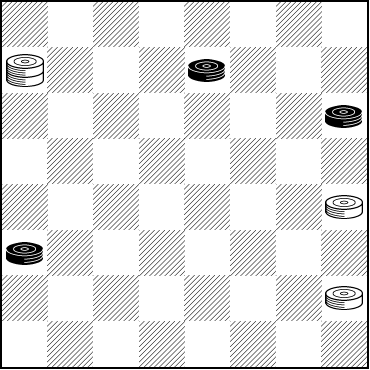
WHITE
White to Play and Win
W:W20,28,K5:B7,12,21.
Ed continues:
"I think of The Long, Crooked Trail as an endgame lesson, rather than as a problem to be solved, except, perhaps, by experts ... However, it seems instructive for a wide range of players."
We certainly agree, although we think it's worthwhile for you to think about the position and see if you have any ideas about the solution, even if you're not yourself an expert player. That will make the actual solution more meaningful when you do look at it later, by trailing your mouse on Read More.![]()
Double Action

We know little about firearms, but we've read that single-action arms have a longer and smoother trigger pull than double-action arms, which are reputed to be at least somewhat safer but perhaps less accurate. We're sure one of our readers could clarify this easily, but we won't even try.
Returning to checkers: regular contributors Lloyd and Josh Gordon of Toronto sent in this position from one of their nightly games, and it's a position that is surely not safe for the Black forces, if White engages in accurate play.
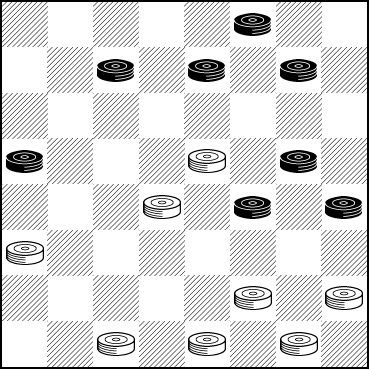
WHITE
White to Play and Win
W:W15,18,21,27,28,30,31,32:B3,6,7,8,13,16,19,20.
It's not hard at all, and the title of today's column gives you a huge hint. So take a "shot" at it and after you've solved it, pull your mouse trigger on Read More to check your solution.![]()
The Death of Expertise
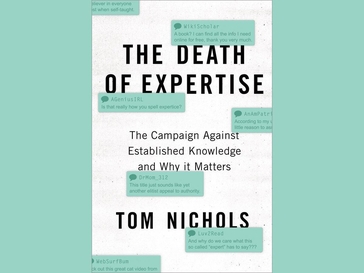
The Death of Expertise, by Tom Nichols, is a book that attempts to make a case for, well, expertise. The author's main points are that in the internet age, everyone thinks they're an expert, and the democratic concept of equality has come to mean that everyone's opinion is equally valid. Mr. Nichols makes a few good points, but then he says this:
"Sensible differences of opinion deteriorate into a bad high school debate in which the objective is to win and facts are deployed like checkers on a board--- none of this rises to the level of chess--- mostly to knock out other facts."
Mr. Nichols' expertise certainly doesn't extend as far as knowing much about checkers, but that doesn't stop him from making a judgment, and thereby becoming guilty of exactly the sort of thing he condemns.
In checkers, expertise comes to the fore. You have it or you don't and there's no faking or pretending. Take, for instance, the following problem, which will require genuine expertise to solve.
WHITE
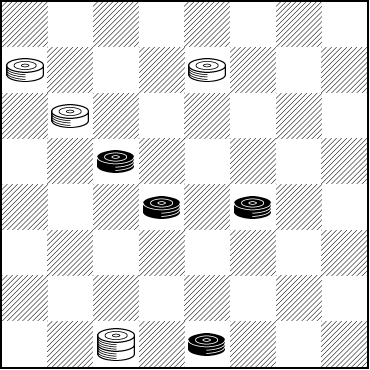
BLACK
Black to Play and Draw
B:WK3,24,26,28:B2,14,15,19.
We think this one will really challenge you. Black has the narrowest of draws and must make a long series of star moves (nine by our count). Rise to the level of checkers (not chess), show your stuff, and do your best on this one. Then check your expertise by clicking on Read More to see the solution.
If you haven't yet reached the expert level, though, don't worry. Working on the problem will in and of itself help you develop, even if in the end you don't find the solution.![]()
Goldilocks
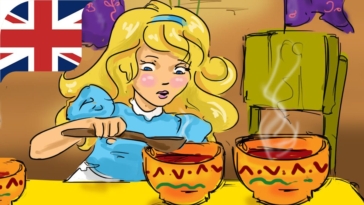
We all know the story of Goldilocks and the Three Bears. There were the porridges that were too hot, and too cold, and just right. There were the chairs that were too big, and too little, and just right. And there were the beds that were too hard, and too soft, and just right.
Brian Hinkle has sent us a checker problem that he calls Goldilocks, because it requires just the right moves at just the right time: not too soon, and not too late.
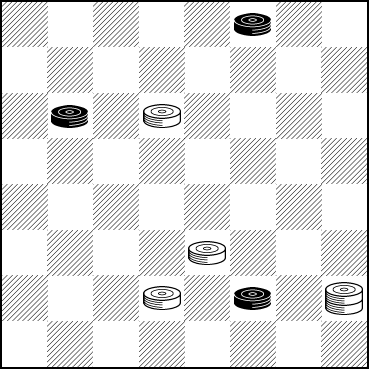
WHITE
White to Play and Win
W:W10,23,26,K28:B3,9,27.
As Brian told us, "White is a man up and has a king, so it should be easy, right?" But of course, it's anything but. This is a master-level problem whose solution eluded many an expert player.
Whatever your skill level, though, this problem rewards careful study and the solution is very pleasing. We know you'll love it when you see it. First, though, do the best you can, and when you've done not too much, and not too little, but just the right amount of study--- be sure to click on Read More to see the solution.![]()
The Checker Maven is produced at editorial offices in Honolulu, Hawai`i, as a completely non-commercial public service from which no profit is obtained or sought. Original material is Copyright © 2004-2025 Avi Gobbler Publishing. Other material is public domain, as attributed, or licensed under Creative Commons. Information presented on this site is offered as-is, at no cost, and bears no express or implied warranty as to accuracy or usability. You agree that you use such information entirely at your own risk. No liabilities of any kind under any legal theory whatsoever are accepted. The Checker Maven is dedicated to the memory of Mr. Bob Newell, Sr.

